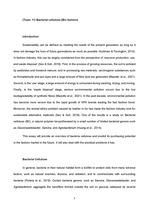Sustainability can be defined as meeting the needs of the present generation as long as it
does not damage the lives of future generations as much as possible (Kuhlman & Farrington, 2010).
In fashion industry, this can be largely considered from the perspective of ‘resource production, use, and waste disposal’ (Seo & Suh, 2019). First, in the process of growing resources, the soil is polluted by pesticides and livestock manure, and in processing raw materials, carcinogenic substances such as formaldehyde and azo dyes and a large amount of fibre dust are generated (Mazotto et al., 2021). Second, in the 'use' stage, a large amount of energy is consumed during washing, drying, and ironing. Finally, in the 'waste disposal' stage, serious environmental pollution occurs due to the low biodegradability of synthetic fibres (Mazotto et al., 2021). In the past decade, environmental pollution has become more severe due to the rapid growth of SPA brands leading the fast fashion trend.
· Andréa, F., De, S., Costa, A., Alice, M., Rocha, V., & Sarubbo, L. (2017). REVIEW -BACTERIAL
· CELLULOSE: AN ECOFRIENDLY BIOTEXTILE. International Journal of Textile and Fashion
· Technology (IJTFT). 7. 11-26.
· https://www.researchgate.net/publication/314234769_REVIEW_-
· BACTERIAL_CELLULOSE_AN_ECOFRIENDLY_BIOTEXTILE#:~:text=The%20bacterial%2
· 0cellulose%20(BC)%20has,role%20of%20a%20textile%20surface.
· Costa, A. F. S., Almeida, F. C. G., Vinhas, G. M., & Sarubbo, L. A. (2017). Production of Bacterial
· Cellulose by Gluconacetobacter hansenii Using Corn Steep Liquor As Nutrient Sources.
· Frontiers in Microbiology, 8. https://doi.org/10.3389/fmicb.2017.02027
· Gabilondo, N., Corcuera, M. A., Prieto, M. A., & Retegi, A. (2017). By-products of the cider
· production: an alternative source of nutrients to produce bacterial
· cellulose. Cellulose, 24, 2071–2082. https://doi.org/10.1007/s10570-017-1263-4
· García, C., & Prieto, M. A. (2019). Bacterial cellulose as a potential bioleather substitute for the
· footwear industry. Microbial biotechnology, 12(4), 582–585. https://doi.org/10.1111/1751-
· 7915.13306
· Huang, Y., Zhu, C., Yang, J., Nie, Y., Chen, C., & Sun, D. (2014). Recent advances in bacterial
· cellulose. Cellulose, 21, 1–30. https://doi.org/10.1007/s10570-013-0088-z
· Kuhlman, T., & Farrington, J. (2010). What is Sustainability?. Sustainability, 2(11), 3436-3448.
· ttps://doi.org/10.3390/su2113436
· Mazotto, A. M., Silva, J. R., Brito, L. A. A., Rocha, N. U., & Soares, A. S. (2021). How can
· microbiology help to improve sustainability in the fashion industry?. Environmental
· Technology & Innovation, 23. https://doi.org/10.1016/j.eti.2021.101760.
· Phruksaphithak, N., Kaewnun, C., & O-Thong, S. (2019). Bacterial cellulose production and
· applications. Science, Engineering and Health Studies, 13(1), 1-7.
· https://doi.org/10.14456/sehs.2019.1
· Portela, R., Leal, C. R., Almeida, P. L., & Sobral, R. G. (2019). Bacterial cellulose: a versatile
· biopolymer for wound dressing applications. Microbial Biotechnology, 12(4), 586-610.
· https://doi.org/10.1111/1751-7915.13392
· Rühs, P. A., Storz, F., Gómez, Y. A. L., Haug, M., & Fischer, P. (2018). 3D bacterial cellulose
· biofilms formed by foam templating. npj Biofilms Microbiomes, 4(21).
· https://doi.org/10.1038/s41522-018-0064-3
· Seo, K., & Suh, S. (2019) . A Study on the Characteristics and Social Values of Vegan Fashion in
· H&M and Zara. Journal of Fashion Business, 23(6), 86-100. https://doi.org/
· 10.12940/jfb.2019.23.6.86
· Wang, J., Tavakoli, J., & Tang, Y. (2019). Bacterial cellulose production, properties and applications
· with different culture methods – A review. Carbohydrate Polymers, 219, 63-76.
· https://doi.org/10.1016/j.carbpol.2019.05.008.

